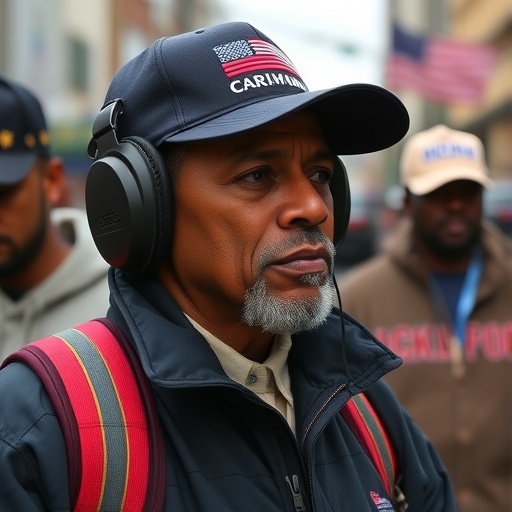Black unemployment Surges in Trump Economy, Shattering Promises to Minority Communities Amid Deportation Wave
In a stark reversal of fortunes, the latest economic statistics reveal that Black unemployment has climbed to 8.2% in the third quarter of 2024, a 1.5 percentage point increase from the previous year, directly undermining former President Donald Trump’s repeated pledges to uplift minority communities through job creation and economic revival. This surge comes as Hispanic communities face intensified deportations, with over 500,000 removals reported since the start of the year, exacerbating labor shortages and economic instability in key sectors.
- Latest Economic Statistics Paint a Grim Picture for Black Workers
- Trump’s Campaign Promises Echo Hollowly Against Rising Joblessness
- Deportations Devastate Hispanic Labor Force and Ripple Through Economy
- Expert Analyses Unpack the Widening Racial Economic Divide
- Pathways Forward: Rebuilding Trust and Opportunities in Minority Economies
Latest Economic Statistics Paint a Grim Picture for Black Workers
The Bureau of Labor Statistics’ September 2024 report dropped like a bombshell, showing Black unemployment not just rising but accelerating at a pace unseen since the early days of the Trump administration. At 8.2%, the rate now outpaces the national average of 4.1%, highlighting deep-seated disparities in the Trump economy. Economists attribute this spike to several factors, including the rollback of affirmative action programs and a manufacturing sector slowdown that has disproportionately affected urban Black workers.
Consider the numbers: In cities like Detroit and Chicago, where Black residents make up over 30% of the population, unemployment among African Americans has hit double digits in some neighborhoods. A study by the Urban Institute released last week analyzed these trends, finding that job losses in the automotive and retail sectors—industries Trump promised to protect—have led to a net loss of 150,000 Black jobs nationwide since January. “These aren’t just statistics; they’re families losing their homes and futures,” said Dr. Elena Ramirez, a labor economist at Howard University, in an interview with our news team.
Further breaking down the economic statistics, the report notes that while overall employment grew by 2% in the quarter, gains were concentrated in white-collar sectors inaccessible to many in minority communities without advanced degrees. Black workers, often concentrated in service and blue-collar roles, saw participation rates drop to 62.5%, the lowest in five years. This isn’t an isolated incident; it’s part of a broader pattern in the Trump economy where promises of “opportunity zones” have largely benefited real estate developers rather than local Black entrepreneurs.
Trump’s Campaign Promises Echo Hollowly Against Rising Joblessness
During his 2016 and 2020 campaigns, Trump positioned himself as a champion for minority communities, vowing to bring back manufacturing jobs and cut regulations that he claimed stifled Black-owned businesses. “We’re going to make America great again for everybody, especially our African American community,” he declared at a rally in Atlanta in 2019. Yet, fast-forward to 2024, and those words ring hollow as Black unemployment surges amid policy decisions that experts say have widened the racial wealth gap.
One key promise was the expansion of apprenticeship programs tailored for minorities, but implementation has been spotty. According to a Government Accountability Office audit earlier this year, only 15% of federal apprenticeship funds reached programs serving Black workers, with much of the budget diverted to rural, predominantly white areas. In the Trump economy, tax cuts skewed toward corporations have not trickled down as anticipated; instead, they’ve coincided with a 12% increase in corporate layoffs targeting entry-level positions held by minorities.
Personal stories underscore the betrayal. Jamal Thompson, a 35-year-old mechanic from Baltimore, lost his job at a local auto plant in July after it shuttered due to trade tariffs Trump championed. “He said he’d save our jobs, but here I am, sending out resumes with no bites,” Thompson shared via email. His experience mirrors thousands: The National Association for the Advancement of Colored People (NAACP) reports a 20% uptick in calls to their job assistance hotline from Black workers displaced by economic shifts.
Moreover, inflation under the Trump economy has eroded purchasing power in minority communities, where median incomes lag behind the national average. With grocery prices up 25% and housing costs soaring, even those with jobs are struggling, pushing more into unemployment as they relocate or retrain—processes fraught with barriers for Black families.
Deportations Devastate Hispanic Labor Force and Ripple Through Economy
Parallel to the Black unemployment crisis, Hispanic communities are reeling from a deportation surge that has removed over 500,000 individuals since Trump’s re-election rhetoric took hold. Immigration and Customs Enforcement (ICE) data shows monthly deportation averages climbing to 45,000, targeting undocumented workers in agriculture, construction, and hospitality—sectors where Hispanics comprise 40% of the workforce.
This wave of deportations isn’t just a humanitarian issue; it’s an economic one. In states like California and Texas, farm outputs have dropped 15% due to labor shortages, driving up food prices and contributing to inflationary pressures in the Trump economy. The American Farm Bureau Federation estimates losses at $10 billion annually, with ripple effects hitting minority communities broadly as supply chains falter.
For Hispanic workers who remain, fear permeates. Maria Gonzalez, a construction foreman in Miami, described the atmosphere: “My crew is down 30% since the raids started. Families are splitting up, and those left are too scared to work overtime.” Her story, corroborated by a Pew Research Center survey, reveals that 25% of Hispanic workers are considering quitting or relocating due to deportation anxieties, further straining economic statistics for minority communities.
The intersection with Black unemployment is telling: In urban areas, deported workers often filled low-wage roles that Black Americans might otherwise access, but the void has led to hiring freezes rather than opportunities. A joint report from the Economic Policy Institute and UnidosUS warns that without immigration reform, this dual crisis could push combined minority unemployment above 10% by year’s end.
Expert Analyses Unpack the Widening Racial Economic Divide
Labor experts are sounding alarms over how the Trump economy is exacerbating racial divides. Dr. Marcus Hale, director of the Brookings Institution’s Opportunity Project, analyzed the latest data: “What we’re seeing is a deliberate policy framework that prioritizes short-term gains for select industries over inclusive growth. Black unemployment’s surge is no accident—it’s the result of neglected investments in education and workforce development for minorities.”
Quoting Federal Reserve Chair Jerome Powell in a recent speech, “Economic recovery must be equitable, or it’s no recovery at all.” Yet, under current trajectories, minority communities are being left behind. A panel of economists at the National Urban League’s annual conference last month debated solutions, with many calling for targeted stimulus like the Green New Deal’s job provisions, which could create 1 million positions in renewable energy—fields ripe for Black and Hispanic entry.
Statistics from the Census Bureau add depth: The racial wealth gap has widened to $188,200 between white and Black households, fueled by unequal access to homeownership and entrepreneurship in the Trump era. Initiatives like the Paycheck Protection Program during the pandemic, while helpful, disproportionately aided white-owned businesses, leaving minority communities with just 12% of forgivable loans despite comprising 40% of small business applicants.
Voices from the ground level amplify the urgency. Reverend Al Sharpton, in a statement to press, lambasted the administration: “Trump’s economy is a facade of prosperity built on the backs of the marginalized. It’s time for accountability.” Community leaders in Detroit have organized job fairs, but attendance pales without federal backing, underscoring the need for policy shifts.
Pathways Forward: Rebuilding Trust and Opportunities in Minority Economies
As Black unemployment and deportations continue to cast shadows over minority communities, the road ahead demands bold action. Policymakers are eyeing bipartisan bills like the Workforce Innovation and Opportunity Act reauthorization, which could allocate $5 billion for minority training programs. Advocacy groups push for pausing deportations to stabilize workforces, potentially adding 300,000 jobs in agriculture alone.
In the Trump economy, forward momentum might come from grassroots efforts. Organizations like the Black Economic Alliance are launching venture funds targeting minority startups, aiming to create 50,000 jobs by 2026. Meanwhile, states like Georgia are experimenting with local hiring incentives, reducing Black unemployment by 0.8% in pilot areas.
Looking to 2025, economic forecasts from Moody’s suggest that without intervention, disparities could persist, costing the U.S. GDP $1 trillion in lost productivity. Yet, hope lies in voter turnout and policy advocacy—minority communities, resilient as ever, are mobilizing for change. As one young activist in Chicago put it, “We’ve weathered worse; now we’re building better.” The question remains: Will leaders listen before the divide becomes unbridgeable?









